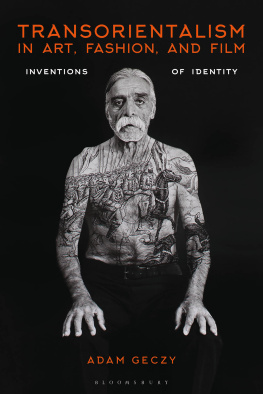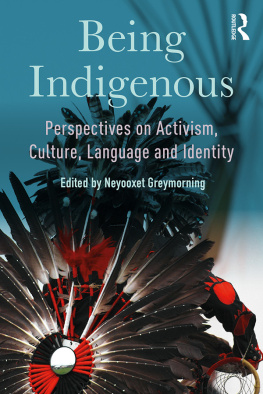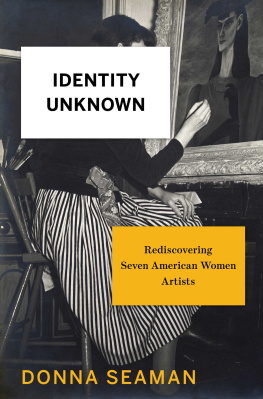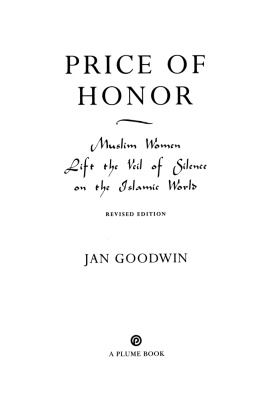
TRANSORIENTALISM
IN ART, FASHION,
AND FILM
Bringing a new perspective and provocative argument to the well-known concept of Orientalism, Adam Geczy elaborates on his earlier book that introduced Transorientalism. His intent smashes the binary worlds of Orient and Occident, West and non-West. He insists shifting boundaries exist within what we have thought as globalization and provides compelling world examples. Geczy pushes readers to question ideas of identity for individuals and cultures about what is fixed, fluid, and hybrid. Geczy proposes we view culture and identity as a balance between what has been imposed and what has been created.
Joanne B. Eicher, Editor-in-Chief, Berg Encyclopedia of World Dress and Fashion, and University of Minnesota, USA
In a sweep from West to East Asia through a number of its visual cultures, as different as Turkish fashion and urban-based Indigenous art, Adam Geczy unpacks a matrix of insurgent aesthetic strategies through which local values have creatively engaged with global currents. He is equally adept at sweeping up into his critical vision the many manoeuvres of contemporary theory as if they are so many specialised weapons to blast structuralisms straightjackets. This is a new voice in a rewarding trend of criticism that, following Edward Saids seminal study of orientalism 40 years ago, deconstructs the East/West binary in productive ways that return agency to those it othered.
Ian McLean, University of Melbourne, Australia
Geczys coinage of Transorientalism is very much of the moment and defines the new Orientalisms of the global new millennium. Erudite, lucid, sensitive and eloquent, the depth of its research and the intellectual range is impressive. It fulfils on its ambitions in a way that few scholars could achieve. Fashion, film and art are used as lenses for the means by which cultural identities are shaped, and re-shaped. There have been many books on cultural formations and on transnational aesthetics, but none like this. This will prove to be an essential resource and a highly influential text for many years to come.
Melissa Chiu, Director of the Hirshhorn Museum, Washington, USA
To Ulrika
Thou by the Indian Ganges side/Shouldst rubies find

CONTENTS
Sultan Abdlhamid (18421918). London Stereoscopic & Photographic Co. Printcollector/Gettyimages.
Turkish woman c. 1885. Photo by Adoc Photos/Corbis via Getty images.
Turkish woman c. 1885. Photo by Adoc Photos/Corbis via Getty Images.
Turkeys ruling Justice and Development Party (AKP) MPs Nurcan Dalbudak (centre) and Sevde Beyazit Kacar (right) attend a general assembly at the Turkish Parliament wearing headscarves in Ankara on October 31, 2013. Four female lawmakers from Turkeys Islamic-rooted government attended a parliament session on October 31 wearing headscarves for the first time since a ban was lifted in the staunchly secular country. Photo: AFP PHOTO/ADEM ALTAN/AFP/Getty Images.
Servet Kocyigit, My Heart Was Not Made from Stone (South America) (2016), 100220 cm, C-type print, courtesy the artist.
Servet Kocyigit, Gold Line 1 (2016), textile collage, embroidery on textile, paint, courtesy the artist.
Servet Kocyigit, Kafka Rose (ongoing multimedia work since 2013), tables, books, perfumes, and scents courtesy the artist.
Halil Altindere. Stills from Wonderland, color video, sound, 825. Courtesy the artist and Pilot Gallery, Istanbul.
Halil Altindere. Stills from Homeland, HD video, sound, 106. Vocals and lyrics Mohammad Abu Hajar, music Nguzunguzu. Commissioned and coproduced by the Berlin Biennale of Contemporary Art, with the support of the SAHA Association. Courtesy the artist and Pilot Gallery, Istanbul.
Shirin Neshat, Rapture (1999). Film stills. Photos by Larry Barns. Courtesy the artist and Gladstone Gallery, New York and Brussels.
Shirin Neshat, Fervor (1999). Film stills. Photos by Larry Barns. Courtesy the artist and Gladstone Gallery, New York and Brussels.
Shirin Neshat, Divine Rebellion, from The Book of Kings series (2012). Acrylic on LE silver gelatin print, 62 49 (157.5 124.5 cm). Copyright the artist and Gladstone Gallery, New York and Brussels.
Ghada Amer, Noah Forever (2009). Acrylic, embroidery, and gel medium on canvas. 36 42 (91.4 106.7 cm). Courtesy the artist and Cheim & Read, New York.
Ghada Amer, Womens Qualities (2000). Eight flowerbeds, dimensions variable. Courtesy the artist and Cheim & Read, New York.
Ghada Amer, The Reign of Terror (2005). Printed cafeteria cups, plates, and paper tray liners; dimensions variable. Courtesy the artist and Cheim & Read, New York.
Nasim Nasr, Zaeefeh (2015), gicle archival digital print on Hahnemulle etching paper. Courtesy the artist.
Nasim Nasr, Forty Pages (2016), gicle archival digital print on 320 gsm white cotton smooth. Courtesy the artist.
Mona Hatoum, Measures of Distance (1988), color video with sound, 1535. Western Front video production, Vancouver, 1988. Courtesy the artist.
Mona Hatoum, Corps tranger (1994), video installation with cylindrical wooden structure, video projector and player, amplifier and four speakers, 350 300 300 cm. Installation view at Centre Pompidou, Paris. Courtesy the artist and Centre Pompidou, Mnam-CCI.
Mona Hatoum, Keffieh (19931999). Human hair on cotton fabric, dimensions variable. Courtesy the artist and White Cube. Photo: Hugo Glendenning.
A model walks the runway during the Guo Pei Haute Couture show at the Fashion 4 Developments 5th annual Official First Ladies luncheon at The Pierre Hotel on September 28, 2015 in New York City. Photo by Neilson Barnard/Getty Images for Fashion 4 Development.
Chinese actors Wu Tao (centre) and Joan Chen (right) on the set of The Last Emperor, directed by Bernardo Bertolucci, 1987. Photo by CHRISTOPHE D YVOIRE/Sygma via Getty Images.
American former professional boxer Mike Tyson and actor Donnie Yen attend the premiere of the film Ip Man 3 directed by Wilson Yip on March 1, 2016 in Beijing, China. Photo by VCG/VCG via Getty Images.
Yasaka Pagoda and Sannen Zaka Street in the Morning, Kyoto, Japan. Photo by Patrick Foto/Getty Images.
Fashion designer Rei Kawakubos dresses present during The Metropolitan Museum of Art Costume Institutes 2017 exhibition as an honored guest in New York, United States on May 2, 2017. Photo by Selcuk Acar/Anadolu Agency/Getty Images.
A hall exhibiting the work of Japanese fashion designer Rei Kawakubo is shown to the media on May 1, 2017, prior to the public opening of the Metropolitan Museum of Arts spring Costume Institute exhibition Rei Kawakubo/Comme des Garcons: Art of the In-Between in New York. The exhibition ran through September 4. Photo by Kyodo News via Getty Images.
Forty cosplayers from twenty nations pose in a photo session during the 2013 World Cosplay Summit in Nagoya on August 3, 2013. The forty cosplayers will compete in the World Cosplay Championships. Photo JIJI PRESS/AFP/Getty Images.
Designer Manish Malhotra and Rina Dhaka during the Michael Kors store launch on February 26, 2014 in New Delhi, India. Photo by Raajessh Kashyap/Hindustan Times via Getty Images.
Indian Bollywood actors Hema Malini (left) and Deepika Padukone (right) pose for a photograph during a promotional event in Mumbai on late October 16, 2017. Photo STR/AFP/Getty Images.
Next page







